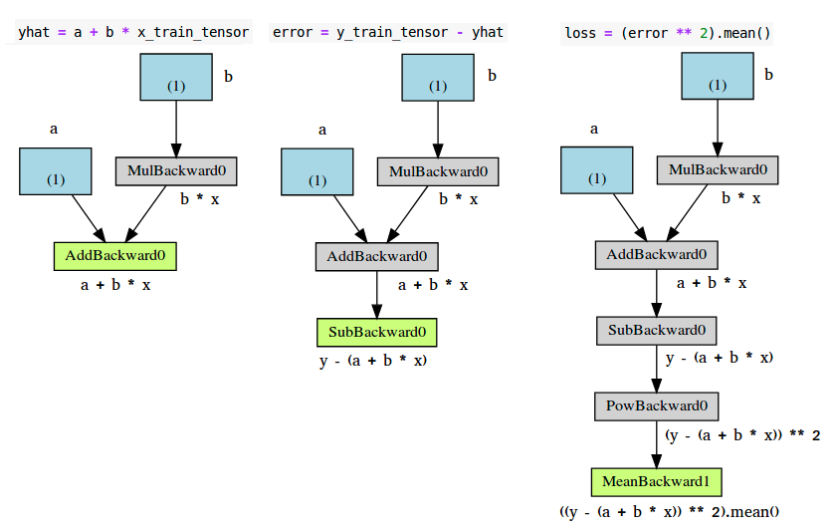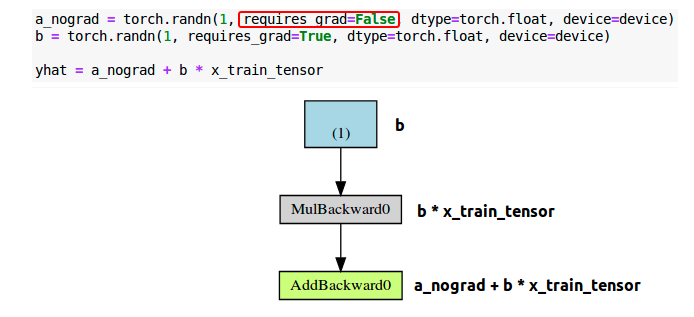首先,声明本文非原创,参考博客:https://shartoo.github.io/2019/10/28/-understand-pytorch/
只是想自己记录一下,更好的理解pytorch的计算。
1、线性回归问题
假定我们以一个线性回归问题来逐步解释pytorch过程中的一些操作和逻辑。线性回归公式如下:

1.1 先用普通的numpy来展示线性回归过程
随机生成100个数据,并以一定的随机概率扰动数据集,训练集和验证集八二分,如下:
1 # 数据生成 2 np.random.seed(42) 3 x = np.random.rand(100, 1) 4 y = 1 + 2 * x + .1 * np.random.randn(100, 1) 5 6 # Shuffles the indices 7 idx = np.arange(100) 8 np.random.shuffle(idx) 9 10 # Uses first 80 random indices for train 11 train_idx = idx[:80] 12 # Uses the remaining indices for validation 13 val_idx = idx[80:] 14 15 # Generates train and validation sets 16 x_train, y_train = x[train_idx], y[train_idx] 17 x_val, y_val = x[val_idx], y[val_idx]

上面这是我们已经知道的是一个线性回归数据分布,并且回归的参数是a=1,b=2 如果我们只知道数据x_train和y_train,需要求这两个参数a,b呢,一般是使用梯度下降方法。
注意,下面的梯度下降方法是全量梯度,一次计算了所有的数据的梯度,只是在迭代了1000个epoch,通常训练时会把全量数据分成多个batch,每次都是小批量更新。
# 初始化线性回归的参数 a 和 b np.random.seed(42) a = np.random.randn(1) b = np.random.randn(1) print("初始化的 a : %d 和 b : %d"%(a,b)) leraning_rate = 1e-2 epochs = 1000 for epoch in range(epochs): pred = a+ b*x_train # 计算预测值和真实值之间的误差 error = y_train-pred # 使用MSE 来计算回归误差 loss = (error**2).mean() # 计算参数 a 和 b的梯度 a_grad = -2*error.mean() b_grad = -2*(x_train*error).mean() # 更新参数:用学习率和梯度 a = a-leraning_rate*a_grad b = b -leraning_rate*b_grad print("最终获得参数为 a : %.2f, b :%.2f "%(a,b))
得到的输出如下:
初始化的 a : 0 和 b : 0
最终获得参数为 a : 0.98, b :1.94
2 pytorhc 来解决回归问题
2.1 pytorch的一些基础问题
- 如果将numpy数组转化为pytorch的tensor呢?使用
torch.from_numpy(data) - 如果想将计算的数据放入GPU计算:
data.to(device)(其中的device就是GPU或cpu) - 数据类型转换示例:
data.float() - 如果确定数据位于CPU还是GPU:
data.type()会得到类似于torch.cuda.FloatTensor的结果,表明在GPU中 - 从GPU中把数据转化成numpy:先取出到cpu中,再转化成numpy数组。
data.cpu().numpy()
2.2 使用pytorch构建参数
如何区分普通数据和参数/权重呢?需要计算梯度的是参数,否则就是普通数据。参数需要用梯度来更新,我们需要选项requires_grad=True。使用了这个选项就是告诉pytorch,我们要计算此变量的梯度了。
我们可以使用如下几种方式来构建参数:
1、此方法构建出来的参数全部都在cpu中:
a = torch.randn(1, requires_grad=True, dtype=torch.float) b = torch.randn(1, requires_grad=True, dtype=torch.float) print(a, b)
2、此方法尝试把tensor参数传入到gpu:
a = torch.randn(1, requires_grad=True, dtype=torch.float).to(device) b = torch.randn(1, requires_grad=True, dtype=torch.float).to(device) print(a, b)
此时如果查看输出,会发现两个tensor ,a和b的梯度选项没了(没了requires_grad=True)
tensor([0.5158], device='cuda:0', grad_fn=<CopyBackwards>) tensor([0.0246], device='cuda:0', grad_fn=<CopyBackwards>)
3、先将tensor传入gpu,然后再使用requires_grad_()选项来重构tensor的属性。
a = torch.randn(1, dtype=torch.float).to(device) b = torch.randn(1, dtype=torch.float).to(device) # and THEN set them as requiring gradients... a.requires_grad_() b.requires_grad_() print(a, b)
4、最佳策略当然是初始化的时候直接赋予requires_grad=True属性了
# We can specify the device at the moment of creation - RECOMMENDED! torch.manual_seed(42) a = torch.randn(1, requires_grad=True, dtype=torch.float, device=device) b = torch.randn(1, requires_grad=True, dtype=torch.float, device=device) print(a, b)
查看tensor属性:
tensor([0.6226], device='cuda:0', requires_grad=True) tensor([1.4505], device='cuda:0', requires_grad=True)
2.3 自动求导 Autograd
Autograd是Pytorch的自动求导包,有了它,我们就不必担忧偏导数和链式法则等一系列问题。Pytorch计算所有梯度的方法是backward()。计算梯度之前,我们需要先计算损失,那么需要调用对应(损失)变量的求导方法,如loss.backward()。
- 计算所有变量的梯度(假设损失变量是loss):
loss.back() - 获取某个变量的实际的梯度值(假设变量为att):
att.grad - 由于梯度是累加的,每次用梯度更新参数之后,需要清零(假设梯度变量是att):
att.zero_(),下划线是一种运算符,相当于直接作用于原变量上,等同于att=0(不要手动赋值,因为此过程可能涉及到GPU、CPU之间数据传输,容易出错)
我们接下来尝试下手工更新参数和梯度
lr = 1e-1 n_epochs = 1000 torch.manual_seed(42) a = torch.randn(1, requires_grad=True, dtype=torch.float, device=device) b = torch.randn(1, requires_grad=True, dtype=torch.float, device=device) for epoch in range(n_epochs): yhat = a + b * x_train_tensor error = y_train_tensor - yhat loss = (error ** 2).mean() # 这个是numpy的计算梯度的方式 # a_grad = -2 * error.mean() # b_grad = -2 * (x_tensor * error).mean() # 告诉pytorch计算损失loss,计算所有变量的梯度 loss.backward() # 打印结果 print(a.grad) print(b.grad) # 1. 手动更新参数,会出错 AttributeError: 'NoneType' object has no attribute 'zero_' # 错误的原因是,我们重新赋值时会丢掉变量的 梯度属性 # a = a - lr * a.grad # b = b - lr * b.grad # print(a) # 2. 再次手动更新参数,这次我们没有重新赋值,而是使用in-place的方式赋值 RuntimeError: a leaf Variable that requires grad has been used in an in- place operation. # 这是因为 pytorch 给所有需要计算梯度的python操作以及依赖都纳入了动态计算图,稍后会解释 # a -= lr * a.grad # b -= lr * b.grad # 3. 如果我们真想手动更新,不使用pytorch的计算图呢,必须使用no_grad来将此参数移除自动计算梯度变量之外。 # 这是源于pytorch的动态计算图DYNAMIC GRAPH,后面会有详细的解释 with torch.no_grad(): a -= lr * a.grad b -= lr * b.grad # PyTorch is "clingy" to its computed gradients, we need to tell it to let it go... a.grad.zero_() b.grad.zero_() print(a, b)
2.4 动态计算图
如果想可视化计算图,可以使用辅助包torchviz,需要自己安装。使用其make_dot(变量)方法来可视化与当前给定变量相关的计算图。示例
torch.manual_seed(42) a = torch.randn(1, requires_grad=True, dtype=torch.float, device=device) b = torch.randn(1, requires_grad=True, dtype=torch.float, device=device) yhat = a + b * x_train_tensor error = y_train_tensor - yhat loss = (error ** 2).mean() make_dot(yhat)
使用make_dot(yhat)会得到相关的三个计算图如下:

各个组件,解释如下
- 蓝色盒子:作为参数的tensor,需要pytorch计算梯度的
- 灰色盒子:与计算梯度相关的或者计算梯度依赖的,python操作
- 绿色盒子:与灰色盒子一样,区别是,它是计算梯度的起始点(假设
backward()方法是需要可视化图的变量调用的)-计算图自底向上构建。
上图的error(图中)和loss(图右),与左图的唯一区别就是中间步骤(灰色盒子)的数目。看左边的绿色盒子,有两个箭头指向该绿色盒子,代表两个变量相加。a和b*x。再看该图中的灰色盒子,它执行的是乘法计算,即b*x,但是为啥只有一个箭头指向呢,只有来自蓝色盒子的参数b,为啥没有数据x?因为我们不需要为数据x计算梯度(不计算梯度的变量不会出现在计算图中)。那么,如果我们去掉变量的requires_grad属性(设置为False)会怎样?
a_nongrad = torch.randn(1,requires_grad=False,dtype=torch.float,device=device) b = torch.randn(1,requires_grad=True,dtype=torch.float,device=device) yhat = a_nongrad+b*x_train_tensor

可以看到,对应参数a的蓝色盒子没有了,所以很简单明了,不计算梯度,就不出现在计算图中。
3 优化器 Optimizer
到目前为止,我们都是手动计算梯度并更新参数的,如果有非常多的变量。我们可以使用pytorch的优化器,像SGD或者Adam。
优化器需要指定需要优化的参数,以及学习率,然后使用step()方法来更新,此外,我们不必再一个个的去将梯度赋值为0了,只需要使用优化器的zero_grad()方法即可。。
代码示例,使用SGD优化器更新参数a和b的梯度。
torch.manual_seed(42) a = torch.randn(1, requires_grad=True, dtype=torch.float, device=device) b = torch.randn(1, requires_grad=True, dtype=torch.float, device=device) print(a, b) lr = 1e-1 n_epochs = 1000 # Defines a SGD optimizer to update the parameters optimizer = optim.SGD([a, b], lr=lr) for epoch in range(n_epochs): # 第一步,计算损失 yhat = a + b * x_train_tensor error = y_train_tensor - yhat loss = (error ** 2).mean() # 第二步,后传损失 loss.backward() # 不用再手动更新参数了 # with torch.no_grad(): # a -= lr * a.grad # b -= lr * b.grad # 使用优化器的step方法一步到位 optimizer.step() # 也不用告诉pytorch需要对哪些梯度清零操作了,优化器的zero_grad()一步到位 # a.grad.zero_() # b.grad.zero_() optimizer.zero_grad() print(a, b)
4 计算损失loss
pytorch提供了很多损失函数,可以直接调用。简单使用如下:
torch.manual_seed(42) a = torch.randn(1, requires_grad=True, dtype=torch.float, device=device) b = torch.randn(1, requires_grad=True, dtype=torch.float, device=device) print(a, b) lr = 1e-1 n_epochs = 1000 # 此处定义了损失函数为MSE loss_fn = nn.MSELoss(reduction='mean') optimizer = optim.SGD([a, b], lr=lr) for epoch in range(n_epochs): yhat = a + b * x_train_tensor # 不用再手动计算损失了 # error = y_tensor - yhat # loss = (error ** 2).mean() # 直接调用定义好的损失函数即可 loss = loss_fn(y_train_tensor, yhat) loss.backward() optimizer.step() optimizer.zero_grad() print(a, b)
5 模型
pytorch中模型由一个继承自Module的Python类来定义。需要实现两个最基本的方法
__init__(self):定义了模型由哪几部分组成,当前模型只有两个变量a和b。模型可以定义更多的参数,并且可以将其他模型或者网络层定义为其参数forwad(self,x):真实执行计算的方法,它对给定输入x输出模型预测值。不要显示调用此forward(x)方法,而是直接调用模型本身,即model(x)。
简单的回归模型如下:
class ManualLinearRegression(nn.Module): def __init__(self): super().__init__() # To make "a" and "b" real parameters of the model, we need to wrap them with nn.Parameter self.a = nn.Parameter(torch.randn(1, requires_grad=True, dtype=torch.float)) self.b = nn.Parameter(torch.randn(1, requires_grad=True, dtype=torch.float)) def forward(self, x): # 计算预测结果 return self.a + self.b * x
在__init__(self)方法中,我们使用Parameters()类定义了两个参数a和b,告诉Pytorch,这两个tensor要被作为模型的参数的属性。这样,我们就可以使用模型的parameters()方法来找到模型每次迭代时的所有参数值了,即便模型是嵌套模型都可以找得到,这样就能将参数喂入优化器optimizer来计算了(而非手动维护一张参数表)。并且,我们可以使用模型的state_dict()方法来获取所有参数的当前值。
注意:模型应当与数据出于相同位置(GPU/CPU),如果数据时GPU tensor,我们的模型也必须在GPU中
代码示例如下:
torch.manual_seed(42) # Now we can create a model and send it at once to the device model = ManualLinearRegression().to(device) # 获取所有参数的当前值 print(model.state_dict()) lr = 1e-1 n_epochs = 1000 loss_fn = nn.MSELoss(reduction='mean') optimizer = optim.SGD(model.parameters(), lr=lr) for epoch in range(n_epochs): # 注意,模型一般都有个train()方法,但是不要手动调用,此处只是为了说明此时是在训练,防止有些模型在训练模型和验证模型时操作不一致,训练时有dropout之类的 model.train() # yhat = a + b * x_tensor yhat = model(x_train_tensor) loss = loss_fn(y_train_tensor, yhat) loss.backward() optimizer.step() optimizer.zero_grad() print(model.state_dict())
6 训练
我们定义了optimizer,loss function,model为模型三要素,同时需要提供训练时用的特征(feature)和对应的标签(label)数据。一个完整的模型训练有以下组成
- 模型三要素
- 优化器optimizer
- 损失函数loss
- 模型 model
- 数据
- 特征数据feature
- 数据标签label
我们可以写一个包含模型三要素的通用的训练函数:
def make_train_step(model, loss_fn, optimizer): # 定义一个训练函数 def train_step(x, y): # Sets model to TRAIN mode model.train() # 模型预测 yhat = model(x) # 计算损失 loss = loss_fn(y, yhat) # 计算梯度 loss.backward() # 更新参数以及梯度清零 optimizer.step()
optimizer.zero_grad() # Returns the loss return loss.item() # Returns the function that will be called inside the train loop return train_step
然后在每个epoch时迭代模型训练
# Creates the train_step function for our model, loss function and optimizer train_step = make_train_step(model, loss_fn, optimizer) losses = [] # For each epoch... for epoch in range(n_epochs): # Performs one train step and returns the corresponding loss loss = train_step(x_train_tensor, y_train_tensor) losses.append(loss) # Checks model's parameters print(model.state_dict())
最后梳理一下pytorch计算的整个流程:
1、创建线性回归的模型类;
2、创建数据;
3、训练调用模型进行预测;
4、计算损失(预先定义损失函数);
5、optimizer.zero_grad() 清空过往梯度;
6、loss.backward() 反向传播,计算当前梯度;
7、optimizer.step() 根据梯度更新网络参数;
8、保存模型;
最后,附上一个完整的线性回归训练及预测模型的代码:
#!D:/CODE/python # -*- coding: utf-8 -*- # @Time : 2020/8/11 19:02 # @Author : Alex-bd # @Site : # @File : pytorch计算逻辑.py # @Software: PyCharm # Functional description:通过线性回归学习pytorch计算逻辑 import os os.environ['KMP_DUPLICATE_LIB_OK'] = 'TRUE' import torch import matplotlib.pyplot as plt def create_linear_data(nums_data, if_plot=False): """ Create data for linear model Args: nums_data: how many data points that wanted Returns: x with shape (nums_data, 1) """ x = torch.linspace(0, 1, nums_data) x = torch.unsqueeze(x, dim=1) b = 3 a = 1 y = a + b * x + torch.rand(x.size()) if if_plot: plt.scatter(x.numpy(), y.numpy(), c=x.numpy()) plt.show() data = {"x": x, "y": y} return data data = create_linear_data(300, if_plot=True) print(data["x"].size()) class LinearRegression(torch.nn.Module): """ Linear Regressoin Module, the input features and output features are defaults both 1 """ def __init__(self): super().__init__() # self.linear = torch.nn.Linear(1, 1) self.a = torch.nn.Parameter(torch.randn(1, requires_grad=True, dtype=torch.float)) self.b = torch.nn.Parameter(torch.randn(1, requires_grad=True, dtype=torch.float)) def forward(self, x): out = self.a + self.b * x return out # # linear = LinearRegression() # print(linear) class Linear_Model(): def __init__(self): """ Initialize the Linear Model """ self.learning_rate = 0.001 self.epoches = 5000 self.loss_function = torch.nn.MSELoss() self.create_model() def create_model(self): self.model = LinearRegression() self.optimizer = torch.optim.SGD(self.model.parameters(), lr=self.learning_rate) def train(self, data, model_save_path="model.pth"): """ Train the model and save the parameters Args: model_save_path: saved name of model data: (x, y) = data, and y = kx + b Returns: None """ x = data["x"] y = data["y"] for epoch in range(self.epoches): prediction = self.model(x) loss = self.loss_function(prediction, y) self.optimizer.zero_grad() loss.backward() self.optimizer.step() if epoch % 50 == 0: print("epoch: {}, loss is: {}".format(epoch, loss.item())) torch.save(self.model.state_dict(), "linear.pth") def test(self, x, model_path="linear.pth"): """ Reload and test the model, plot the prediction Args: model_path: the model's path and name data: (x, y) = data, and y = kx + b Returns: None """ x = data["x"] y = data["y"] self.model.load_state_dict(torch.load(model_path)) prediction = self.model(x) print('a= ', self.model.a, end=" ") print("b= ", self.model.b) plt.scatter(x.numpy(), y.numpy(), c=x.numpy()) plt.plot(x.numpy(), prediction.detach().numpy(), color="r") plt.show() def compare_epoches(self, data): x = data["x"] y = data["y"] num_pictures = 16 fig = plt.figure(figsize=(10, 10)) current_fig = 0 for epoch in range(self.epoches): prediction = self.model(x) loss = self.loss_function(prediction, y) self.optimizer.zero_grad() loss.backward() self.optimizer.step() if epoch % (self.epoches / num_pictures) == 0: current_fig += 1 plt.subplot(4, 4, current_fig) plt.scatter(x.numpy(), y.numpy(), c=x.numpy()) plt.plot(x.numpy(), prediction.detach().numpy(), color="r") plt.show() linear = Linear_Model() data = create_linear_data(100) linear.train(data) # linear.test(data) # linear.compare_epoches(data)